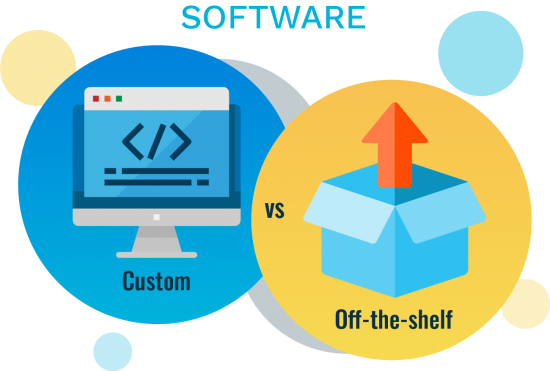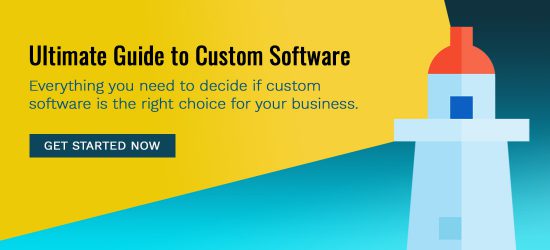|
Getting your Trinity Audio player ready...
|
When your business is faced with a choice between off-the-shelf and custom software for mission critical applications, there are many aspects to consider; Not the least of which is balancing short-term gains with long-term business objectives.
While every business, software project and application are unique, when analyzing the buy, build or hybrid software options with our clients, we’ve found there are common factors that can sway our recommendations and the decision towards a specific approach.
It Comes Down To Your Requirements
Choosing between off-the-shelf and custom software is a business decision and as such, requires detailed discovery, analysis and documentation of your needs today and well into the future. Whitecap accomplishes this using our tried and tested software development process. Through this process, you can clearly define the objectives, functional requirements and future needs of your software. By the end of this exercise, you should have a clear view if you can meet your goals with an off-the-shelf, fully customized or hybrid software solution.
1. Functionality Fit
With so many great off-the-shelf software options on the market today, you should start by assessing if any of those packages can meet all or most of your functional needs. If a commercial software package can meet 70-80% of your requirements out-of-the box, go with it and customize what you can or bend a little on your requirements. But if you need to customize 50% or more of the base application to get the functionality you need, that might start to present some obstacles to achieving your business objectives and tip the scales in favour of full custom software development project. Here’s why:
- You’ll spend a lot of time tinkering with something that’s not 100% right (and might never be).
- When a commercial software package gets updated, customizations will likely be impacted.
- The cost of the package, combined with the custom software development, increases incrementally.
- Maintaining the software can get tricky.
2. Business Processes Alignment
Next, you should consider how entrenched your business processes are. Software applications map their solution to a predefined business workflow. So, if you’re flexible in terms of how the application delivers on your business requirements (what you need it to do and how), an off-the-shelf package remains a good starting point.
However, if you can’t or won’t change your processes or workflows to align with the software package, you’ll never be satisfied with how the application is working (and you’ll incur lots of extra costs as you try to force the application to fit your way of working). In this case, custom software is the right choice.
3. Unique Business, Industry or Application
For commonly used and “mature” business applications like ERP, CRM or e-commerce solutions, there are a lot of highly configurable, off-the-shelf options that can do the job. But if you are running a very unique business with unique data processing needs or very specialized workflows that are not supported by any packaged solutions, custom development is the way to go.
Look at Woodbine Entertainment as an example: The online horse racing and wagering systems we’ve built, and continue to support, for them are very specialized, so there isn’t anything out there in terms of off–the–shelf solutions that does what they want.
Similarly, if you’re looking to disrupt an industry or introduce new technology like artificial intelligence (AI) to your solution, a high degree of customization will likely be required to help you stand out from the competition.
It’s important to consider that when we talk about the “uniqueness” of a business, we’re not necessarily talking about your innovative approach to the market, brand identity or cutting-edge strategy. It could simply come down to your data processing requirements and workflows which are different from other businesses in your industry.

4. Cost-Based Analysis
The total investment required to acquire and implement a given solution is an important consideration when choosing between custom and off-the-shelf software. When comparing costs, you need to look at the complete picture from upfront development or implementation, to ongoing operational and maintenance costs.
Let’s tackle a couple of common misconceptions:
- Build it and forget it: It might be tempting to believe that custom software, while more expensive upfront, is a one-time cost. The reality is you still need to budget for on-going enhancements, maintenance and support.
- Set monthly cost: You might favour off-the-shelf software because it comes with a predictable monthly price tag after the initial configuration/customization. But the monthly cost can quickly skyrocket (20-30% a year) as you add new modules, increase storage capacity or the number of users to meet your expanding business needs, or pay the vendor’s recurring support/maintenance fees.
Bottom line, the cost of custom vs. off-the-shelf software may end up being fairly similar in the long run, so you need to consider what the initial investment requires (development, customization or configuration) including end-user training, and what are the post-launch support costs.
Beyond dollars and cents, the driving factor in the selection process must be fully addressing the most pressing needs of the business with the solution you choose.
5. Taking Control
One big advantage to choosing a custom software solution is control.
You control how and when you update or change your application, as well as when you add new features or remove functionality that’s no longer needed.
You can also choose to ramp up or turn down investment in your solution to align with your business needs at any given time. With a commercial solution, you have no say over how the vendor enhances the product, licensing fee increases or changes to the way they charge for the application (monthly fees, one-time product purchase or annual licensing).
6. Custom Software as an Asset
Custom software can become an asset on a business’ balance sheet. When you’re in a highly competitive industry, having a custom foundation can be a sizeable business differentiator and value generator.
Depending on where you live, there may be government financial and tax incentives to consider when looking to deploy a custom software solution. Do your research and make sure you consider this during the requirements phase.
And, one day if you decide to sell your business your wholly owned custom software solution at the heart of your business, may in fact be the most attractive asset you have to someone looking to acquire your company.
Making the Right Choice Between Off-the-Shelf and Custom Software
With the range of available off-the-shelf software platforms, and options for hybrid or fully custom solutions, make sure you devote a good chunk of time to defining your requirements, researching all your options and weighing the pros and cons.
It can be an overwhelming process so consider getting input from an expert who can help clarify which option is best suited to your business needs today and future growth goals.
Weighing your options for a new software solution for your business? Need help? Let’s talk.
